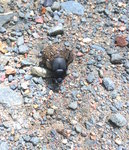 Narrowsburg
NarrowsburgLight Rain Fog/Mist, 43°
Wind: 8.1 mph
 Narrowsburg
NarrowsburgThe flagstone walkway surrounding our house is a favored place for the eastern American toads ( Bufo americanus ) that share our forested yard. At this time of year, knobby toads of various sizes and …
Stay informed about your community and support local independent journalism.
Subscribe to The River Reporter today. click here
This item is available in full to subscribers.
Please log in to continue |

The flagstone walkway surrounding our house is a favored place for the eastern American toads (Bufo americanus) that share our forested yard. At this time of year, knobby toads of various sizes and earthy colors typically appear on the cool and smooth stones, harvesting insects and worms that emerge following rains or when drawn to the pool of light flooding the path when the motion lights are triggered.
This practice on the part of our warty neighbors increases their risk of being harmed by inattentive walkers traversing the path. We make efforts to improve our awareness of their whereabouts to avoid stepping on them and are rewarded with the opportunity to observe these interesting amphibians going about their lives.
Doing so can lead to a better understanding of, and a deeper connection with, the place one calls “home.” For example, a dark-skinned toad has lived in the crawl space under our house for years. In trying to determine whether this was the same toad appearing every summer, I learned that some toads and frogs can live up to 20 years in the wild and 30 years in captivity. I look forward to our annual re-acquaintance as we weather the years in a silent, but comfortable, co-existence.
Paying attention to the part of the world where our feet touch the earth can also provide interesting and entertaining moments that reveal our interconnectedness with other life forms in surprising ways. I was recently walking my dogs along a dirt road on Pennsylvania state game lands. One of the dogs pooped in the scruffy growth along the road’s edge. As we passed the spot on our return trip roughly 20 minutes later, we encountered two lucky dung beetles taking advantage of the unexpected resource deposited in their habitat.
This undeniably industrious species feeds mostly on feces. (Try saying that five times fast!) Vital members of nature’s cleanup crews, dung beetles not only remove waste products from the environment but also contribute to nutrient recycling, improving soil structure in the process.
In this case, the busy beetles I saw also provided an entertaining glimpse of how this species expertly manages to bring home dinner by rolling it into a ball and propelling it backward using its hind legs. Impressive!
Take care when you are out there exploring the beautiful Upper Delaware River region. Countless compelling lifeforms abound and deserve our attentive respect for their well-being. You will find yourself rewarded with surprising riches.
Comments
No comments on this item Please log in to comment by clicking here